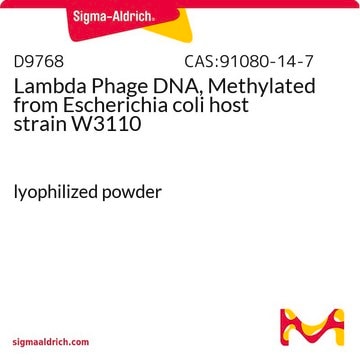10745782001
Roche
DNA, lambda
from bacteriophage lambda cl857 Sam 7
Synonyme(s) :
lambda dna
About This Item
Produits recommandés
Niveau de qualité
Forme
solution
Poids mol.
32,300 kDa
Conditionnement
pkg of 1 mL
Fabricant/nom de marque
Roche
Conditions de stockage
avoid repeated freeze/thaw cycles
Concentration
250 μg/mL
Impuretés
RNA, none detected
nuclease, none detected
Couleur
colorless
Solubilité
water: miscible
Conditions d'expédition
dry ice
Température de stockage
−20°C (−15°C to −25°C)
Description générale
Application
Qualité
Séquence
Forme physique
Stockage et stabilité
Autres remarques
Code de la classe de stockage
12 - Non Combustible Liquids
Classe de danger pour l'eau (WGK)
nwg
Point d'éclair (°F)
No data available
Point d'éclair (°C)
No data available
Certificats d'analyse (COA)
Recherchez un Certificats d'analyse (COA) en saisissant le numéro de lot du produit. Les numéros de lot figurent sur l'étiquette du produit après les mots "Lot" ou "Batch".
Déjà en possession de ce produit ?
Retrouvez la documentation relative aux produits que vous avez récemment achetés dans la Bibliothèque de documents.
Les clients ont également consulté
Notre équipe de scientifiques dispose d'une expérience dans tous les secteurs de la recherche, notamment en sciences de la vie, science des matériaux, synthèse chimique, chromatographie, analyse et dans de nombreux autres domaines..
Contacter notre Service technique







